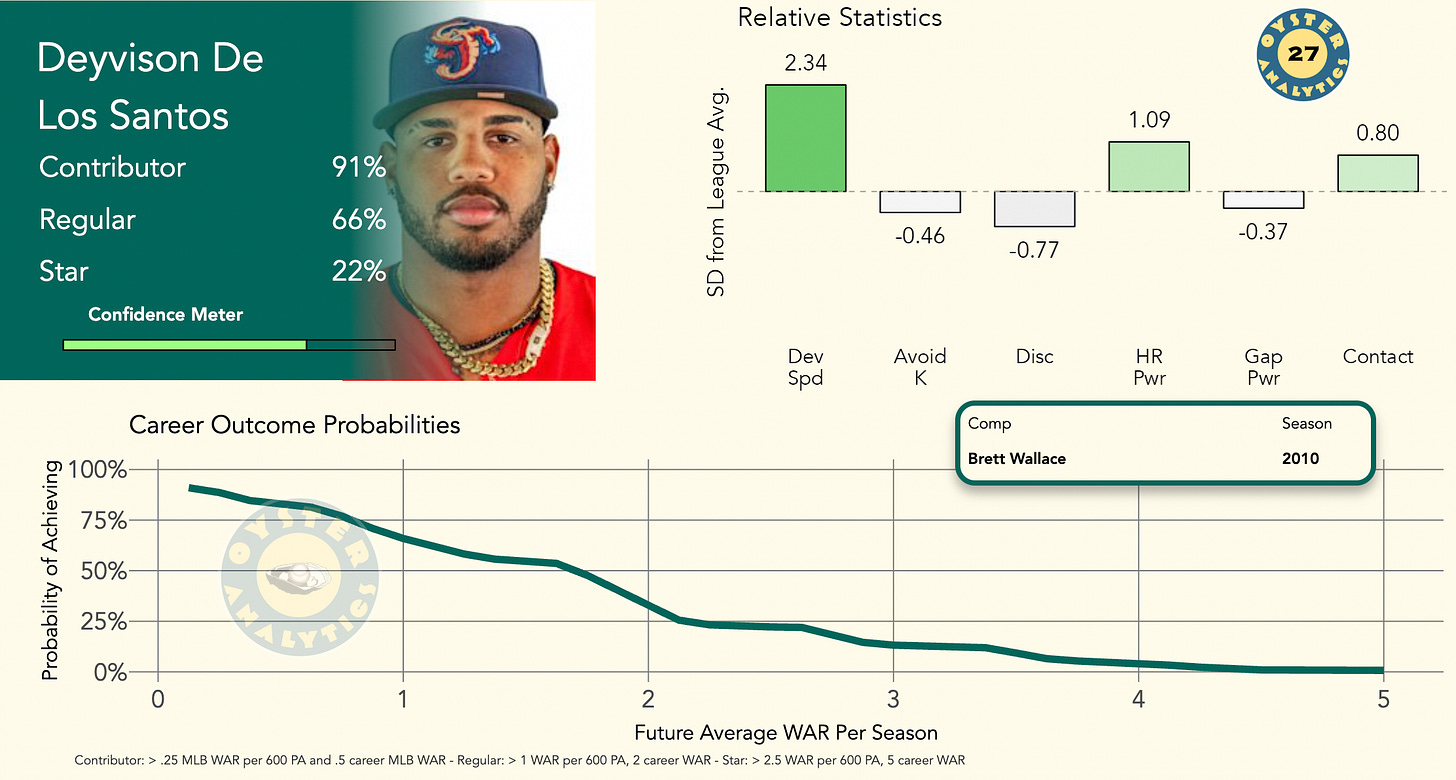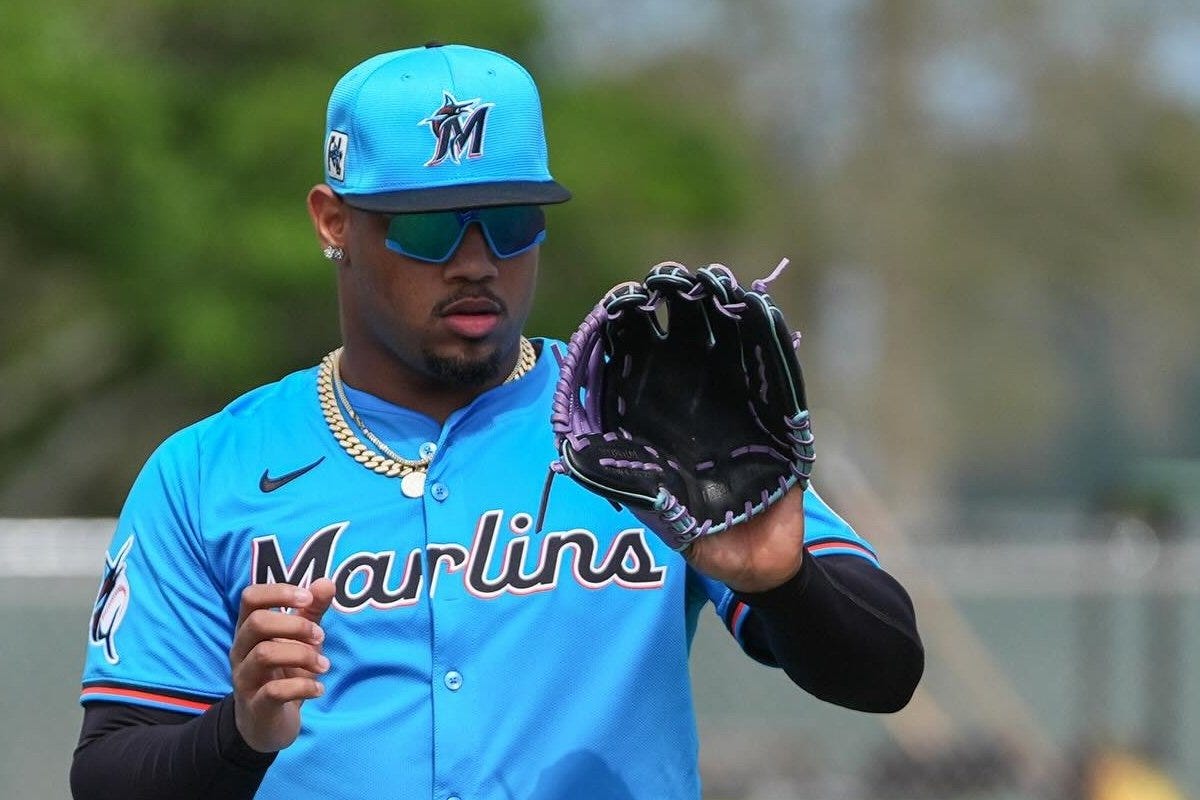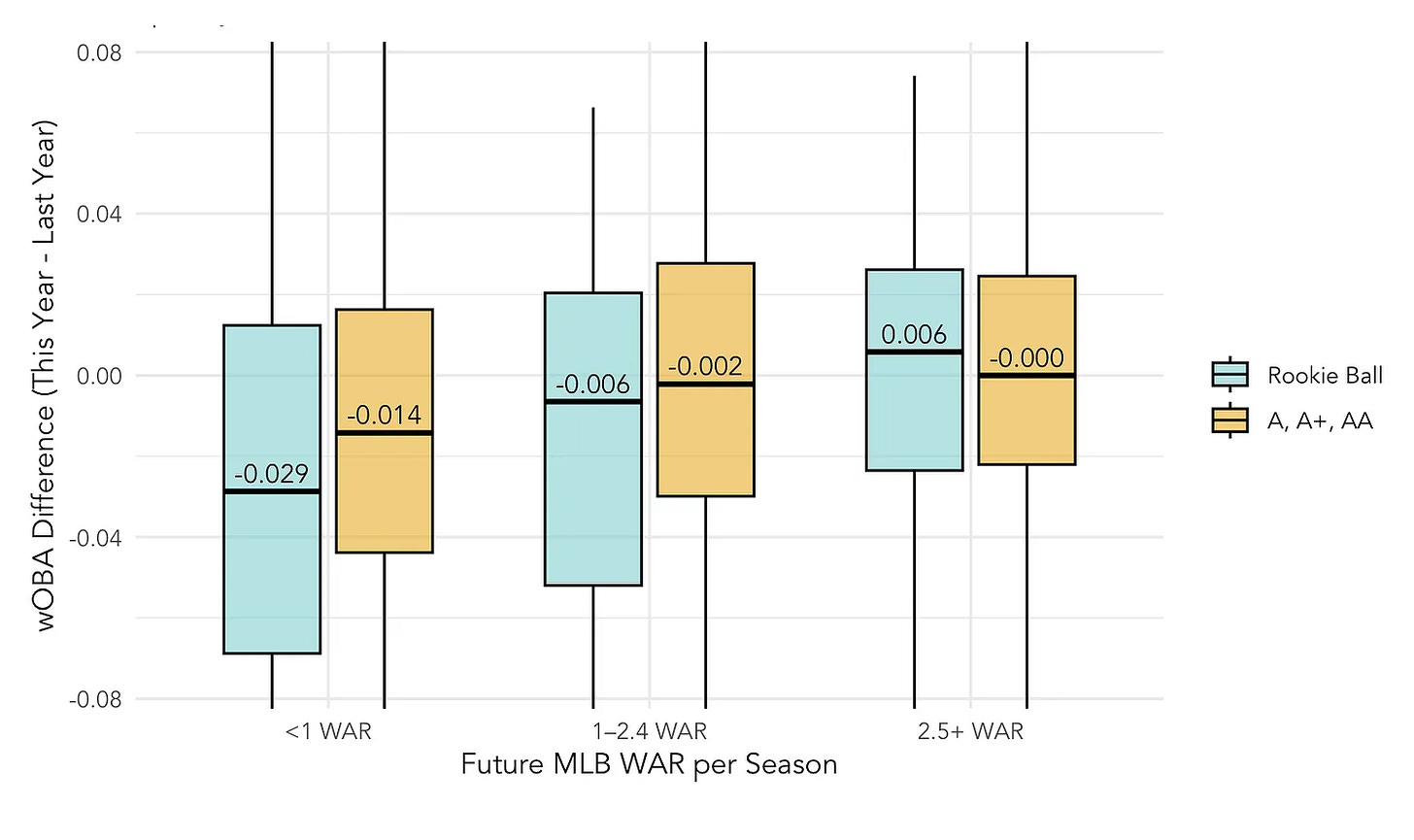Five Prospects Ready to Hop Off the Struggle(ish) Bus
Five guys we’re bullish on who are due to up their game in the second half of 2025
As we assessed our preseason rankings heading into 2025, few names were as surprising on our top 50 as Blaze Jordan. A once-hyped high school home run king with a baseball movie villain aura, Jordan had lost much of his luster heading into this season. He struggled in Double-A in 2023 and 2024, and looked at risk of stalling out in the high minors; we weren’t sure what the model saw in him to warrant such a high ranking. Our model never bailed on Jordan, and its faith was rewarded with a breakout season thus far, dominating Double-A and continuing to rake on the doorstep of the show.
This article is dedicated to players like Jordan, who are currently struggling to produce at a high level, but we still believe in them as future impact players. Some of these players are struggling at a mature age for their level, some are unlucky, and others are showing some traits of successful players but have yet to add the strength, skill, or polish to be present-day standouts. Whatever the rationale for their current woes, we’re willing to give these guys the benefit of the doubt, and we think you should too!
(All stats as of afternoon June 25, 2025)
Leo De Vries, SDP, High-A, Age 18
Our number one overall prospect for some time now, De Vries hasn’t had an exceptional 2025, posting a middling .731 OPS in High-A. While this does translate to a 105 wRC+, we’d expect our top prospect to be a clear standout star… right? De Vries’ accomplishments become more apparent when remembering that he’s only 18 years old in High-A; he’s a bit younger than fast-rising Jesús Made and around the same age as Luis Peña, who are both having solid seasons but, vitally, are plying their trade at one level below De Vries.
In our most recent piece on prospect development, we highlighted the impact of climbing levels on overall productivity. We expect the median player who climbs up a level to produce a .015 worse wOBA than in their previous season at a lower level, as illustrated in the chart below:
wOBA Change When Promoted or Repeating a Level, Rookie Ball Through Triple-A
De Vries’ progress has been just a bit worse than the expected growth curve, with his wOBA down .021 points from last season, further contextualizing his struggles as non-abnormal and well within the range of standard development.
De Vries is also doing a good job of pulling and elevating (42.9% pull%, 35.8% ground ball% ), but a 24.3% infield fly ball rate has capped his ability to take advantage of that profile in 2025. As he adjusts to more mature pitching, we expect that infield fly ball percentage to drop to a more sustainable level, allowing the pop to shine through. A 14.2% walk rate and 20.4% strikeout rate also display the possibility for progress as the plate understanding is clearly there; if he were striking out in the upper-twenties or higher, we’d be far more bearish on his developmental path. Additionally, De Vries continues to play a solid shortstop, another plus from a projection standpoint. He has real potential to stick there, and possesses the raw tools to be a strong MLB infielder.
Key Takeaway: Don’t let the current production fool you, a young player flashing solid potential at a high level relative to his age is rare. The foundation is there, and he doesn’t exhibit the scary red flags that correlate with stagnation.
Deyvison De Los Santos, MIA, Triple-A, Age 23
After a minor league-leading 40 HRs in 2024, De Los Santos has struggled to maintain his power this season, clubbing only seven in 181 Triple-A plate appearances. While he performed worse in 2024 post-trade to the Marlins (part of the A.J. Puk deal), he still hit five more homers in only 13 more plate appearances. So what gives? Elevation may be a factor in his overall productivity; despite controlling for park factors in our projections, De Los Santos' 2024 success was at elevation (AA Amarillo is at 3,600’, AAA Reno at 4500`). Our only in-season comparison point here was his hitting five jacks in 18 Double-A away games, compared to nine in 20 at elevated Amarillo, a small sample that doesn’t prove much for or against the “elevation fraud” allegations.
We are leaning more toward meaningful swing and approach changes as the catalyst for his temporarily reduced power, but these shifts may make De Los Santos a better overall prospect. His key issue in 2024 was his big chase rate, as he swung at a whopping 45.6% of balls! Remarkably, his exploratory swing decisions didn’t translate to Ks (he kept a respectable 24.7% strikeout rate), but perhaps worse, his chases resulted in a poor 5.8% walk rate. This combo of chase and low walks was unlikely to scale up to the show, where many of his brute force ground ball base hits on out of zone pitches would likely turn into whiffs when facing nastier stuff. This year, De Los Santos has cut his chase rate to 32.2%, a massive positive shift. The walks have nearly doubled, as he’s walking 9.4% of the time in Triple-A, a far more sustainable approach.
The future Marlin looks to recapture his power stroke
De Los Santos’ other issue in 2024 was his high ground ball rate (49.6%), a warning sign of a possible limit to his massive power ceiling. This year, he’s turning those ground balls into line drives, upping his line drive percentage over ten percentage points to 33.3% in Triple-A and lowering his ground ball rate to 42.6%. On the downside, his fly ball rate is also down around four percentage points to 24.1%, and his infield fly ball rate is at a scary 34.6%. Clearly, De Los Santos is putting in effort to lift, and he’s made both positive and negative gains from the shift. We’re eager to see if he can dent that infield fly ball rate as the year continues; if he can maintain this lift without the weak flies, his production should balloon!
Key Takeaway: While 40 homers is (likely) out of the question for 2025, we like the revamped De Los Santos. His swing changes show improvement in all the right places, and he’s a few gains from being a difference maker. Don’t let the “step back” deceive; we believe these shifts set him up for more sustainable MLB success.
Welbyn Francisca, CLE, Single-A, Age 19
(Side note—does the Guardians’ photographer have something against Francisca? He still doesn’t have an official photo!)
As of about six weeks ago, Francisca was having an extremely poor season, coming nowhere close to performing to the very high expectations we’d set for him in our preseason rankings. We owned up to this in our self-audit, but also wrote:
“Although we certainly acknowledge that Francisca has been struggling, it’s not quite as bad as it looks. He’s still walking more than he strikes out, and his BABIP has been a horrific .174, which is more than a 200-point drop from his mark last year. We can realistically expect that to rise by a good 100 points over the course of a full season of play…We still have him down for a solid 2025 that will include a hot streak due to hit any day now.”
Given we’re quoting ourselves, you know this is heading towards a nice self-congratulatory pat on the back. Since then, Francisca’s BABIP has risen 132 points, and not long after we published that article, he went on a scorching hot streak from May 15 - June 15 in which he hit .394 and stole 16 bases to boot. He’s come back down to earth since, but has gotten his wRC+ up to 106. A disastrous start has become a slightly above-average first half.
While that might seem disappointing for a guy we ranked the 10th best hitting prospect in the business going into the year, we still have a lot of faith that better things are to come. Being slightly above average in Single-A at just 19 is impressive! Furthermore, Francisca has good sticky tools (tools that are difficult to improve and don’t often degrade) - he very rarely strikes out while actually walking at a decent clip, a rare combination. We’re betting on Francisca having a strong second half and finishing the season with a wRC+ of about 120.
But there are two asterisks when it comes to Francisca. First, he is very small. We tend not to give too much credence to size in our evaluations, given the tendency for so many scouts to over-weigh it, but it could be a legitimate concern with Francisca. He’s listed at 5’8” 148 pounds. That is not anywhere in the bell curve of MLB profiles. Jose Altuve clocks in 20 pounds heavier. Maybe Francisca puts on a ton of muscle and makes this comment seem silly in a few years’ time, but maybe he doesn’t. It’s difficult to say.
Second, Francisca is repeating the level. Yes, he’s still young for Single-A, but regression when repeating is not a great sign. For now, we’re chalking the initial major slide backwards up to very bad batted ball luck. But a lot hinges on this second half of the season for our future projections of Francisca–if he struggles again, it may be an indication that it was actually the extremely strong 2024 that was down to luck. We trust in him, but we’re also adherents of a “trust but verify” modus operandi.
Key Takeaway: His batted ball skills and past elite performance against older competition suggest Francisca is a great pure hitter who is due to have a strong second half, but size concerns and his struggles repeating a level do raise questions about his ceiling.
Samuel Zavala, CWS, High-A, Age 20
Zavala was a key part of the Dylan Cease to San Diego trade, and at the time, he was a promising Single-A prospect with solid power and pure hitter potential. Since the trade, Zavala has struggled in High-A, hitting .187 in 2024 and still running a sub-.700 OPS in 2025. With things looking so grim, why are we still on board?
Zavala has an ideal profile for a yank and lift player: a 43.4% fly ball percentage to accompany a career high 53.4% pull percentage. Ultimately, Zavala’s fly ball happy profile demands either a high exit velocity swing or exceptional discipline and high-quality contact to turn into productivity, and neither seems like a particular strength for Zavala. One hint to his low output could be his 75%+ contact rates in 2024 and 2025, both high numbers that are typically good signs, but if his contact quality is low, or his launch angle on his fly balls is too high, he would be hitting into easy outs. We wish we had Statcast data on Zavala, as these metrics would provide insight into exactly why his otherwise advantageous profile leads to mediocre results. An added bonus is a plus glove, and he’s still seeing the majority of his games in CF, another positive signal for his projectability.
Despite all that, Zavala does have a solid base from which to add power. With some players, a power surge would make them marginally more productive, but if they hit too many ground balls or spray the ball too much, they may be unable to fully utilize the new juice (or, just be James Wood). Zavala’s got the skill set to complement a power increase, and while all the major outlets have written him off, we aren’t so convinced of his demise. After all, he’s still only 20 (about to turn 21) and entering his prime strength-gaining years. We believe a redemption arc is possible, especially considering the numerous positive comments from scouting outlets on his makeup.
Key Takeaway: Now may be a low point, but his hitting profile is a base on which success is built. If he adds a bit of pop, we may see him realize his lofty early career projections.
Jesus Baez, NYM, High-A, Age 20
This is a bit of a cheat. Baez has been playing well (but not exceptionally well), but no one seems to give him any credit for it! Baez is a shortstop in High-A who just turned 20 earlier this year, who grades out to have 60 raw power according to Fangraphs, and who last year churned out a 120 wRC+ in Single-A and a stint in High-A as a teenager. This year, he’s back at it, posting a 121 wRC+ so far in 60 games in High-A. So what gives?
Well, Baez may be performing well on the field, but he doesn’t fit the role of a star prospect. He’s just 5’10” and did not immediately stand out in his international amateur free agent class. He put up an average DSL season, followed by a slightly below-average year in the complex. That was enough for him to get lost in the shuffle as focus shifted to guys putting up monster numbers in those leagues.
But crucially, when Baez got his first taste of full-season ball in Single-A the following year, unlike most of his peers, his performance did not regress; rather, it improved. Last week, we identified this as a key indicator for future success in the show–great DSL and complex stats are great, but what’s more telling is how well players handle the step into Single-A. Baez absolutely aced this test, improving his average, power numbers, and strikeout rate. That’s a rare feat when climbing levels! As shown in the chart below, the guys who accomplish it are much more likely than the average player to go on to big league success.
wOBA Change Upon Promotion, by Level Promoted From
By being in that rare air of guys who actually improve when taking this step, Baez makes himself a favorite of ours for future success. What’s more, the fact that he’s still playing shortstop suggests that no matter where he ends up in the show, he’ll be a strong contributor on the defensive side of the ball. Most of all, Baez is again hitting well against older competition, suggesting there’s even better things to come when he matures. He pulls the ball at a good clip and elevates just enough to put up decent power numbers for a young shortstop. People might think we’re crazy for having him as our second-highest Mets prospect, but we’re sold!
Key Takeaway: There’s little reason to believe Baez won’t hit well in the second half, and after a full season of strong production in High-A, we suspect he’ll be much higher on a lot of folks’ prospect lists heading into a 2026 that should see him tested in Double-A.
Who’s your turnaround candidate? Which fallen prospect stars do you believe will rise again? Let us know who we’ve missed here or at Oyster Analytics or Down on the Farm on X or Bluesky!












